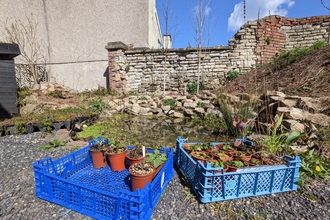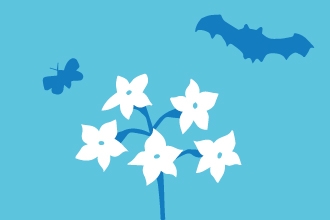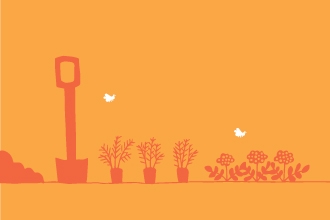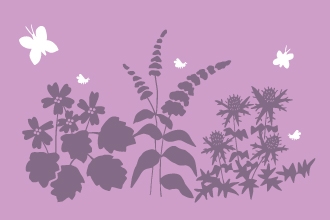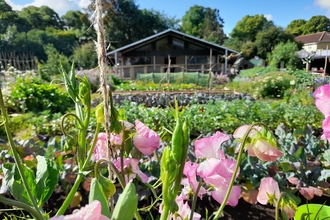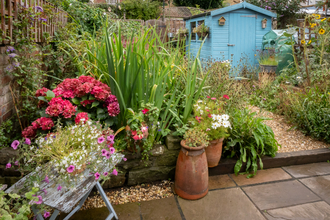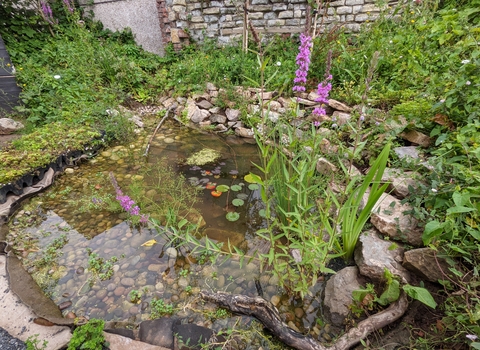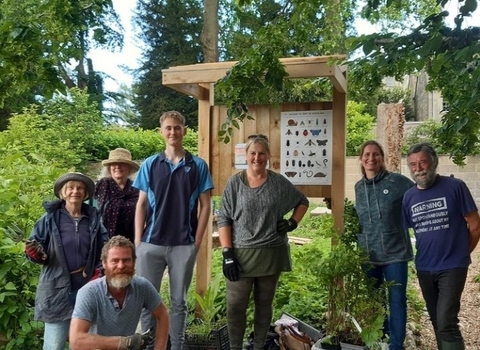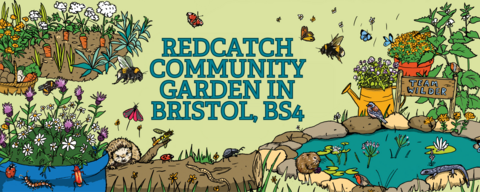
Hannah Bunn
Community space: Redcatch Community Garden
Name: Redcatch Community Garden
Category: Community space in the wildlife gardening competition 2023
Area: Knowle, Bristol, BS4
Redcatch Community Garden was set up in 2017 when a passionate group of volunteers turned a disused bowling green into a vibrant outdoor space to benefit the local community. It brings people together to learn, socialise, share skills and experiences, and improve their health and wellbeing. Examples of some of the things on offer at RCG are the Green Social Prescribing 'Gardening for Wellbeing' Group, providing vital impact measurement as part of an NHS test and learn trial. They specialise in offering Art Therapy and Wellbeing one to one and group sessions, supporting ACE and SEND children, individuals with dementia and their careers and people experiencing low mental health and isolation.
Redcatch Community Garden run many different group session, exercise classes, crochet and knitting groups, educational sessions to local pre-school and primary school children, School holiday activities, cooking and providing free meals to our community, local school and foodbank as part of our Welcome Spaces and Feeding Bristol programme. A range of social and community events from live music, pop up street food events, silent discos, markets and much more!
What makes your garden wildlife friendly?
We are as wildlife friendly as we can be. We have lots of different habitats and areas that attract different kinds of species such as a little wildflower meadow area, a poly-culture area alongside the tennis court boundary, plenty of edibles growing in the market Garden, as well as our cut flower beds. We have lots of different fruit trees, hops and a wildlife corridor at the back of the Garden, living willow archway and two poly-tunnels growing veggies and flowers to attract lots of different pollinators.
Tell us what your group loves about your garden
It is a sanctuary in the city for all to use, be that to come along on their own for a cuppa to sit and relax, or by bringing local people together to learn, socialise, share skills and experiences, and improve their health & well-being. We have regular volunteers that help out in all areas of the garden who love being part of the RCG Family and engaging with the wider community.
Examples of some of the things on offer at RCG are the Green Social Prescribing 'Gardening for Wellbeing' Group. We offer Art Therapy and art groups, different exercise classes, crochet and knitting groups, educational sessions to local pre-school and primary school children, School holiday activities, cooking and providing free meals as part of our Welcome Spaces and Feeding Bristol programme, free live music and pop up street food events to name but a few.
Produce grown in our Garden mainly goes into our kitchen to make healthy, nutritious meals to sell from our cafe or made into jarred products such as Hot Chilli Sauce. Minimal air miles!
It's great to be creating such a diverse habitat for both wildlife and humans to enjoy in an urban, high density environment.
Stephanie Chadwick
What wildlife have you seen in your garden?
We have lots of different species of birds, bees, insects and mammals. For example only yesterday we saw Red Admiral butterflies, cabbage white butterflies, parasitic wasps, bumble bees, snails, slugs, blackbirds, caterpillars and ladybirds. We also have had hedgehogs, badgers and foxes in the garden.
Redcatch Community Garden won!
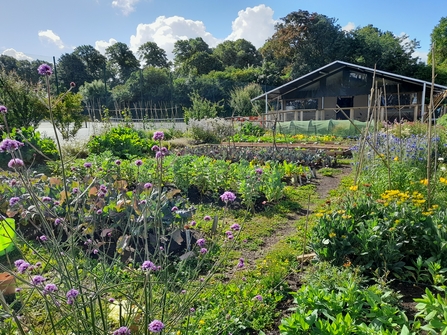
Redcatch Community Garden by Sophie Bancroft
Grow your own Comfrey to harvest and make your own Comfrey Tea plant food, it will save you lots of money.
Companion planting - plant Calendulas with your Carrots, Marigolds with your Tomatoes, the flowers encourage predators of pests and are invaluable.Redcatch Community Garden
Feeling inspired?
Visiting Redcatch Community garden is a huge inspiration, especially when you speak with the staff, amazing volunteers or take part at an event there. As mentioned in the video, Redcatch Community Garden will be developing the space more for pollinators and encourage nearby gardens and outdoor spaces to join activity to create more green corridors - which can be done in any area and will make a huge difference to nature in the area.
Clearing area's with wildlife in mind Round the back of the garden is space for an education area. This currently comprises mostly nettles and scrub. I recommend that you retain some of this vegetation in the proposal as species, such as nettles, can still be valuable for pollinators. When clearing other parts of the vegetation for features, ensure that it is cleared outside of nesting bird season (nesting bird season is March-August). When cutting back vegetation in the winter, care should be taken to avoid disturbing hibernation sites for reptiles and amphibians and therefore try to avoid cutting large areas of dense vegetation.
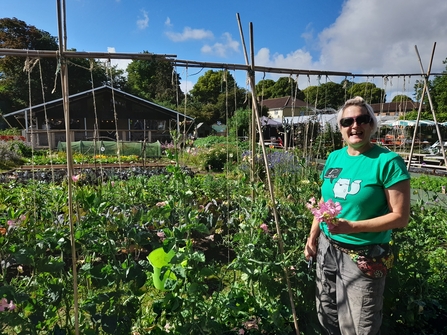
Redcatch Community Garden by Sophie Bancroft
West of England Combined Authority Community Pollinator Fund
Redcatch Community Garden received Community Pollinator Funding from the West of England Combined Authority.
Habitat creation: working with volunteers, the local community and nearby schools has enabled over 16,000m2 of new habitat space in and around the garden and park, as well as linking and creating green corridors, essential for the survival of wildife. This includes new planetrs and borders, raised beds, a sensory garden, wildlife pond and living wall for pollinators all year round, during the day and night.
Community: Local school visits will give experience and motivation for children to create pollinator habitats at school and at home. Redcatch Community Garden hold regular sessions for the public and green social prescribing as well as many other events to appeal to the wants and needs of the local community.
Recommended habitats/ actions for nature:
- Scrub and edible species, such as hawthorn, dogwood, guelder rose or holly to improve diversity and provide food for birds throughout the year. Please note that blackthorn produces suckers and that this can cause long-term issues in neighboring land. Edible species can also be grown to engage the children and this can include bramble, garlic mustard, ground elder, bittercress, nettle and herbs.
- Hibernaculum: along the scrubby boundaries, This can comprise of underground chambers that amphibians and reptiles could use in the winter. A hole can be dug and filled with logs, branches and rocks, making sure to leave plenty of gaps. The hole can then be covered with soil and plug plants or a ‘tussocky’ grass seed mix can be sown on top of the mound. Dead wood piles could also be created along the nature trail to provide features for invertebrates, amphibians and reptiles.
- Mini ponds: As well as a larger pond in the garden, small mini ponds add more stepping stones for wildlife. Ponds are one of the best things you can do for wildlife. Start with a mini-pond.
Team Wilder Ponds

Redcatch Community Garden by Sophie Bancroft
- Climbing plants: Climbers can be added to the vertical space (alongside the hops), such as walls and fences, to enhance the value for wildlife. Species such as ivy, honey suckle, climbing rise, passion flower and jasmine could be grown. Honey suckle is a night-scented plant so would also attract moths which would then benefit bats that use the wildlife corridor.
- Bug hotel: Materials include wooden pallets, bricks, dead leaves, woody material such as sticks/twigs etc. I also recommend that you put a planter on top of it and plant some wildflowers for pollinators too. Use materials already in the garden or nearby.
Create a bug hotel - Plant for pollinators: there are many wildflowers that are beneficial for bees, butterflies and other important pollinators. They're also beautiful to see. You can plant them in garden borders, in a wild patch, in containers or pots.
The best plants for bees and pollinators
Team Wilder mini meadows
Create a container for wildlife
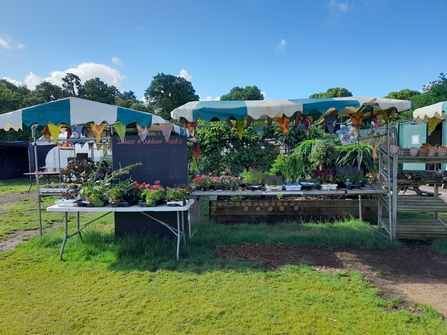
Redcatch Community Garden by Sophie Bancroft
Resources

West of England Combined Authority and Natural History Consortium
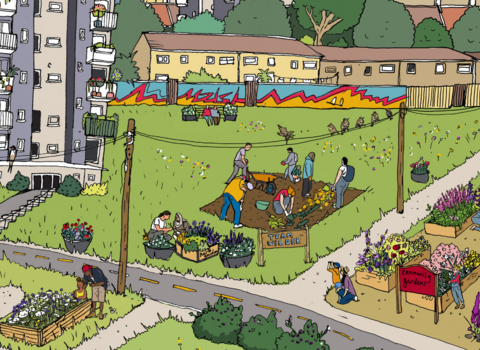
(C) Hannah Bunn
Be part of Team Wilder
Feeling inspired by this wildlife garden? Try something for yourself at home, in your community, school, business or land, no matter the size.
All actions for nature collectively add up and makes a difference for people and wildlife.
Share your actions for nature, like Redcatch Community Garden, and motivate others to do the same.
Log your actions for nature on the map




